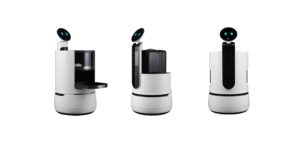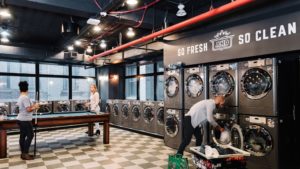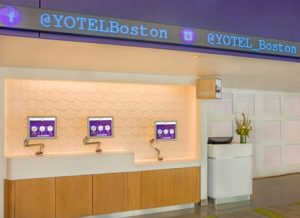The cutting edge of hotel amenities in 2018 covers a lot of ground. Where there was once a utilitarian lobby, there’s now space for guests to hang out with their electronics. What used to be a token bit of exercise equipment has expanded to include sophisticated wellness offerings. Once upon a time, guests sought their travel experiences away from their lodgings; now hotels are adding designs and features to be part of that experience.
 The hotel industry is using its current prosperity to experiment with a variety of amenities undreamed of only a generation ago. Not because business is bad now, but because in an age of potential disruptors—Airbnb might only be the beginning—the race is on to capture the future of hospitality.
The hotel industry is using its current prosperity to experiment with a variety of amenities undreamed of only a generation ago. Not because business is bad now, but because in an age of potential disruptors—Airbnb might only be the beginning—the race is on to capture the future of hospitality.
In short, hotels are staking their future on attracting Millennials. In the mid-2010s, even as the industry recovered from the recession in a very solid way, the worry was there: Can hotels compete for the rising generation against the likes of Airbnb? So far, the answer seems to be yes.
 Recently, Resonance Consultancy released its 2018 Future of Millennial Travel Report, a survey of more than 1,500 active U.S. Millennial travelers. One finding was that despite 52 percent of respondents saying they use services like Airbnb, that kind of service isn’t actually their first choice. Only 23 percent said that a short-term rental was their preferred type of accommodation according to cpexecutive.com.
Recently, Resonance Consultancy released its 2018 Future of Millennial Travel Report, a survey of more than 1,500 active U.S. Millennial travelers. One finding was that despite 52 percent of respondents saying they use services like Airbnb, that kind of service isn’t actually their first choice. Only 23 percent said that a short-term rental was their preferred type of accommodation according to cpexecutive.com.
Rather, Millennial travelers cited full-service hotels as their first choice, followed by staying with friends or family. Not only that, a fair number of the respondents said they preferred upscale or luxury hotels and resorts among hotel sectors. In their accommodation tastes, the rising generation isn’t that different from their elders, they just want more and different amenities.
“A lot of the hotel companies are focusing on Millennial travelers,” said Pinkowski & Co. founder Chuck Pinkowski, a hotel consultant with more than 30 years in the business. “Their preferences are significantly different from the older generation, and hotels have picked up on that. They’re customers today, but they’re also customers of the future.”
 More precisely, Pinkowski pointed out, hotels aren’t devising an assortment of amenities for a particular age group but rather a mindset. A connected, social-media-inclined mindset that values experiences. It just so happens that Millennials tend to exhibit this mindset. So do some older travelers.
More precisely, Pinkowski pointed out, hotels aren’t devising an assortment of amenities for a particular age group but rather a mindset. A connected, social-media-inclined mindset that values experiences. It just so happens that Millennials tend to exhibit this mindset. So do some older travelers.
Moreover, he said, the trend isn’t confined to the top of the hotel market, though luxury and upper-upscale properties can certainly spend more on their amenities. The drive to make hotel amenities more interesting is also emerging in mid-level properties.
According to reports are published in cpexecutive.com Andreas Löcher, head of investment management hospitality at Union Investment Real Estate GmbH, which has acquired a number of U.S. hotels, agreed with that assessment. “Some features that might have been exclusive in the past—such as a signature restaurant, a rooftop bar, a gym, or a grab-and-go market—have already become kind of a standard in the high-profile segments.”
“The most remarkable change I’ve seen in hotels recently is in the lobbies,” Pinkowski said. “Enter a lobby of some of the newer hotels in the mid-day and you’ll see groups of people with their laptops out, or individuals with headphones sitting around, working.”
Hotels are revamping their public spaces in a variety of new ways, but more often than not, the new lobbies end up connected, offering some kind of grab-and-go food service, and are a lot more visually (or otherwise) interesting that they used to be.
At the newly opened Moxy Times Square, a Marriott brand, guests check in with a crew member at dedicated kiosks—if they haven’t already accessed keyless entry through the Marriott Mobile App. Rather than a standard newsstand, the lobby features New Stand, a New York-based chain of boutique convenience stores that offers everything from a toothbrush to a mini-piñata.
Bar Moxy is in the second-floor lobby lounge, serving as the social heart of the hotel, with a copper-wrapped bar at its center and natural light during the day through a triple-height atrium skylight. On one side, the lounge offers flexible seating areas and power outlets for co-working. On the other side, divided from the bar area by sliding, copper-framed glass doors, are three “studios”—multi-purpose rooms with AV equipment that can be combined for meetings, events or private parties.
“Travelers’ needs are rapidly evolving, and the hotel industry is still playing catch-up,” said Mitchell Hochberg, president of The Lightstone Group, which developed the hotel. “Today’s travelers don’t need a newspaper at their door or a mint on their pillow. They want to be engaged by unique experiences that create a sense of place.”
Amenities that promote wellness are increasingly important to travelers, and hotels are obliging them. Take spas, for example. According to the Resonance Consultancy’s Future of Millennial Travel Report, spas are as important as fitness centers among “very desirable” hotel amenities (according to 18 percent respondents) and are more prized than interior design/style (which 17 percent termed “very desirable”).
Counterintuitively, more men than women in the survey said that they think spa facilities are desirable (38 percent of men to 29 percent of women), and they ranked them just ahead of fitness centers (37 percent of men consider these desirable compared to 24 percent of women).
Cpexecutive.com further quoted that the Hotel Crescent Court in the Uptown neighborhood of Dallas recently unveiled its newly renovated, 22,000-square-foot spa and fitness center. The spa features 16 treatment rooms, women’s and men’s lounges, relaxation rooms, a couples suite, whirlpool with a hot and cold dip, a dry sauna, and a nail salon offering manicure stations and pedicure thrones.
There’s also a spa lounge complete with freshly squeezed organic juice and champagne. The spa’s retail offerings have been revamped as well, with such products as Epicuren, Cosmedix, emerginC, ALO and Beyond Yoga apparel. Other facilities include a fully refurbished health and fitness center, featuring new TechnoGym equipment, flooring and lighting.
“For Millennials, health, fitness and wellbeing are experienced in very different ways than for previous generations, all of which influences their expectations when they travel,” Resonance Consultancy posited. “The wealthy among them were the first generation brought up with organic food as a touchstone, exotic travel as a birthright and taking matters into their own hands as technology’s gift to their generation.”
Taking matters into their own hands can mean, finding a hotel that offers experiences unlike those of previous generations. Since the end of the recession—and probably even before that—experiential hotel design and amenities have been gathering steam. And with no precise definition of what experiential really means, they are taking many forms.
“What we see now is that the overall amenity design of a hotel plays a central role and often drives innovation, particularly in the lifestyle hotel segment,” Union Investment’s Löcher said. “Lifestyle hotels have the ambition to create a unique atmosphere and make the customer have a great experience, one that he or she might also talk about with friends and colleagues.”
Hotels are trying a lot of things:
■ The Mandarin Oriental Las Vegas recently installed a vending machine for Moet. Guests purchase a $20 voucher from the front desk if they want to use it.
■ The Kimpton Mason & Rook Hotel in Washington, D.C., has partnered with Shinola to offer a Watch Butler service for guests, who may borrow (at no extra cost) a handmade Shinola watch during their stay.
■ At the Residence Inn by Marriott Los Angeles LAX/Century Boulevard, a robot makes standard room deliveries. It will also deliver coffee from the Starbucks in the hotel lobby.
■ At each 21c Museum Hotel, according to chief hospitality officer Sarah Robbins, a flock of limited-edition penguin sculptures by artist collective Cracking Art is on permanent exhibition. Each has its own color. “The mission of Cracking Art is to raise awareness of environmental issues and the use and misuse of natural resources by creating artworks with materials derived from petroleum products, Robbins explained. The penguins move throughout the hotel: in the lobby, elevators, restaurant and occasionally may show up in a guest room. We allow and encourage our guests to take photos with them, dine with them and enjoy their company.”

































